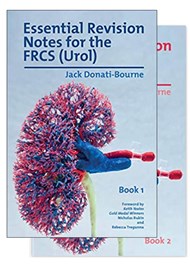In the past a Professor of Urology was frequently quoted as saying “the curriculum for urology is urology”. Indeed that it is, but that definition did not give trainees at the time the much needed framework for navigating through a rather vast breadth of topics spanning several subspecialties. Just as no sailor would head off into the deep without a map or compass, no trainee should be without this handy guide.
This very useful two-volume set provides that map to guide trainees through various key areas of urology without being caught in a quagmire of detail. The FRCS (Urol) is a difficult but fair examination, and preparation for it requires careful collation of notes, lists and tables from various sources; this much-needed book brings all this together to make life easier at a time that is stressful for most trainees. The author is a final year specialist trainee, and this provides a unique and much-needed fresh perspective, particularly with regard to the level at which the information is pitched.
Although the volumes are entitled ‘Essential Revision Notes for the FRCS (Urol)’ I believe trainees should read these from the very start of specialty training and not just in the months leading up to the exam. This will provide a framework on which to build more in-depth knowledge from a reading of the key papers, guidelines and textbooks conveniently listed after each section. The included multiple choice questions are useful for facilitating retention of key facts. Information is presented in a user-friendly format with tables and key fact lists that are required to be memorised and can be easily referenced when required.
The softback, concise format makes it easy to carry around to enable a quick read whenever there may be a few minutes to spare. Learning is a lifelong process and takes time and hard work, but the reward is truly profound: a knowledge of the basic science and evidence base for clinical practice enables development of an insightful and informed practice which eventually results in improved patient care. This will be transformative for all everyday clinical scenarios, whether it be when providing clarity and reassurance on the natural history of physiological phimosis, understanding how to interpret a bladder diary to treat nocturia, or discussing outcomes for prostate cancer treatment. Jack Donati-Bourne should be applauded for his stalwart effort in putting together this information together, which will no doubt help a large number of trainees, both current and future.





